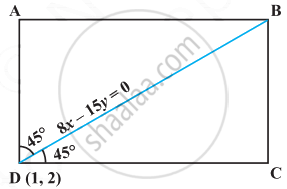Advertisements
Advertisements
प्रश्न
If one diagonal of a square is along the line 8x – 15y = 0 and one of its vertex is at (1, 2), then find the equation of sides of the square passing through this vertex.
उत्तर
Let ABCD be the given square and the coordinates of the vertex D be (1, 2).
We are required to find the equations of its sides DC and AD.
Given that BD is along the line 8x – 15y = 0, so its slope is `8/15` (Why?).
The angles made by BD with sides AD and DC is 45° (Why?).
Let the slope of DC be m.
Then tan 45° = `(m - 8/15)/(1 + (8m)/15)` (Why?)
or 15 + 8m = 15m – 8
or 7m = 23, which gives m = `23/7`
Therefore, the equation of the side DC is given by
y – 2 = `23/7 (x - 1)` or 23x – 7y – 9 = 0.
Similarly, the equation of another side AD is given by
y – 2 = `(-7)/23 (x - 1)` or 7x + 23y – 53 = 0.
APPEARS IN
संबंधित प्रश्न
Find the slope of a line, which passes through the origin, and the mid-point of the line segment joining the points P (0, –4) and B (8, 0).
Find the angle between the x-axis and the line joining the points (3, –1) and (4, –2).
Consider the given population and year graph. Find the slope of the line AB and using it, find what will be the population in the year 2010?

Find the values of k for which the line (k–3) x – (4 – k2) y + k2 –7k + 6 = 0 is
- Parallel to the x-axis,
- Parallel to the y-axis,
- Passing through the origin.
Find the slope of the lines which make the following angle with the positive direction of x-axis:
\[\frac{3\pi}{4}\]
What is the value of y so that the line through (3, y) and (2, 7) is parallel to the line through (−1, 4) and (0, 6)?
Show that the line joining (2, −3) and (−5, 1) is parallel to the line joining (7, −1) and (0, 3).
Without using Pythagoras theorem, show that the points A (0, 4), B (1, 2) and C (3, 3) are the vertices of a right angled triangle.
Consider the following population and year graph:
Find the slope of the line AB and using it, find what will be the population in the year 2010.

Find the angle between X-axis and the line joining the points (3, −1) and (4, −2).
Find the equations of the bisectors of the angles between the coordinate axes.
Find the equation of a line which is perpendicular to the line joining (4, 2) and (3, 5) and cuts off an intercept of length 3 on y-axis.
Find the equation of the strainght line intersecting y-axis at a distance of 2 units above the origin and making an angle of 30° with the positive direction of the x-axis.
Find the image of the point (3, 8) with respect to the line x + 3y = 7 assuming the line to be a plane mirror.
Find the angles between the following pair of straight lines:
3x + y + 12 = 0 and x + 2y − 1 = 0
Find the angles between the following pair of straight lines:
(m2 − mn) y = (mn + n2) x + n3 and (mn + m2) y = (mn − n2) x + m3.
Find the acute angle between the lines 2x − y + 3 = 0 and x + y + 2 = 0.
Show that the tangent of an angle between the lines \[\frac{x}{a} + \frac{y}{b} = 1 \text { and } \frac{x}{a} - \frac{y}{b} = 1\text { is } \frac{2ab}{a^2 - b^2}\].
The equation of the line with slope −3/2 and which is concurrent with the lines 4x + 3y − 7 = 0 and 8x + 5y − 1 = 0 is
The coordinates of the foot of the perpendicular from the point (2, 3) on the line x + y − 11 = 0 are
If m1 and m2 are slopes of lines represented by 6x2 - 5xy + y2 = 0, then (m1)3 + (m2)3 = ?
The line passing through (– 2, 0) and (1, 3) makes an angle of ______ with X-axis.
The intercept cut off by a line from y-axis is twice than that from x-axis, and the line passes through the point (1, 2). The equation of the line is ______.
Find the equation of the line passing through the point (5, 2) and perpendicular to the line joining the points (2, 3) and (3, – 1).
Find the equation of one of the sides of an isosceles right angled triangle whose hypotenuse is given by 3x + 4y = 4 and the opposite vertex of the hypotenuse is (2, 2).
The equation of the straight line passing through the point (3, 2) and perpendicular to the line y = x is ______.
Equation of the line passing through (1, 2) and parallel to the line y = 3x – 1 is ______.
| Column C1 | Column C2 |
| (a) The coordinates of the points P and Q on the line x + 5y = 13 which are at a distance of 2 units from the line 12x – 5y + 26 = 0 are |
(i) (3, 1), (–7, 11) |
| (b) The coordinates of the point on the line x + y = 4, which are at a unit distance from the line 4x + 3y – 10 = 0 are |
(ii) `(- 1/3, 11/3), (4/3, 7/3)` |
| (c) The coordinates of the point on the line joining A (–2, 5) and B (3, 1) such that AP = PQ = QB are |
(iii) `(1, 12/5), (-3, 16/5)` |
